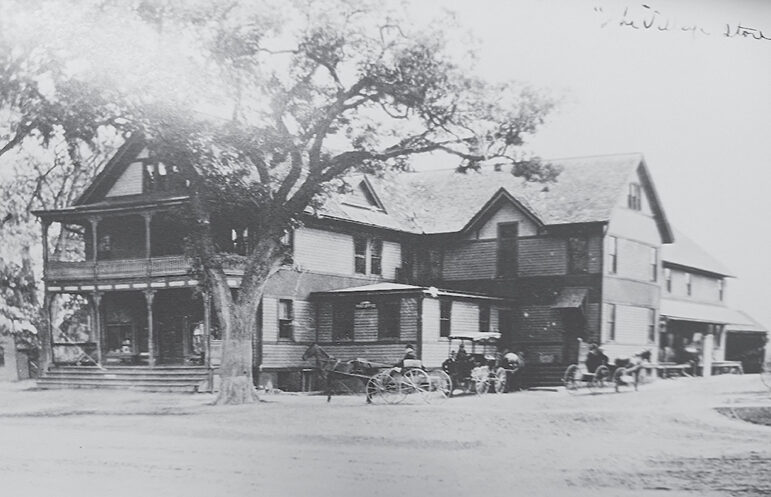
Fifty years ago an iconic landmark, the Loomis Bros. Store in the center of Granby was torn down and with it a piece of the town’s sense of place and history disappeared. Only a few people in town remember it as the Loomis Bros. Store when Edwin Shattuck was the last proprietor of the store. Ray Hanna and George Guay took it over in September 1941, transforming it from a general store into a grocery store that specialized in high-quality meats.
The Loomis Bros. Store building stood for more than eighty years before Hanna and Guay took it over. During those eighty years, the building was the true “hub” of Granby. Everyone went there to buy groceries, animal feed, farm equipment, clothes, shoes, pots and pans, and to pick up their mail. Prior to the early 20th century, people would travel in horse-drawn wagons to get their supplies. Often the farmers bought on credit and paid the Loomis brothers after the harvest. The Loomis brothers were so well financed that they held people’s mortgages, until they were paid back. Anyone traveling through the center of Granby couldn’t miss the large landmark in the center of town across from the green.
Beyond commerce, the store also served as the seat of local government. Town meetings were held upstairs and the building stored Granby’s official records. Community organizations including St. Mark’s Mason Lodge No. 91 A.M & A.F., used the second floor for its meetings before relocating to the old Odd Fellows Hall on East Granby Road. For many years there was an apartment on the second floor that many Granby newlyweds rented and the back ell housed the farm equipment business owned by Tracy Crouse and Howard Carlson.
When Hanna and Guay turned the general store into a grocery store, the goods they’d sold—such as boots, farm equipment, hardware and clothes—were being sold at the W. Kenneth Avery Store (the Grass Roots building). After Hanna retired in 1947, Bill Kellogg became George Guay’s partner. Guay & Kellogg was the go-to place to shop. Guay was considered one of the best butchers in the state, drawing customers from miles around while Bill Kellogg handled general goods. Kellogg was known for his habit of smashing burned-out light bulbs behind the store that had been returned for replacement.
In 1962, a Grand Union grocery store opened in the Center Shops, to compete with Guay and Kellogg. In that same year, Guay and Kellogg built a new store on Bank Street, which is now Geissler’s. After 21 years, George Guay left the Loomis building but retained ownership and rented space to other businesses. For the next thirteen years the building had a host of businesses such as Bob Levandowski’s The Sporting Yankee recreational vehicle dealership, a barber shop, Houston’s Antiques, a ceramic shop, as well as a pizza shop that competed with ABC Pizza.
In 1972, the town had ideas about what to do with the Loomis Store. The town had asked the Conn. Department of Transportation to fix accident-prone Routes 189, 10 and Park Place at the town green. A conceptual development plan presented to the town by architect William Stewart proposed closing Park Place and realigning routes 10 and 189 at a right angle. There was no mention of tearing down the Loomis Bros. Store.
Economic troubles later in the decade changed everything. By 1975 tenants were leaving. George Guay decided to sell the building to the Southern New England Telephone Company. He told the tenants he was selling the building, and they would have to move. The telephone company struck a deal with the State of Connecticut, in which the state would tear down the Loomis building to access the land to connect Rte. 189 to Rte. 202/10. The remaining land was retained by the telephone company.
When demolition day came, townspeople gathered to watch as a bulldozer bit into the 84-year-old landmark. As the structure came down, historic papers, such as old receipts, World War One posters, invoices and other pieces of the town’s past, floated through the air. Some spectators went into the building to get more papers. Police Chief Algren and his officers restored order and barricaded the site. By the end of the day, the Loomis Bros. Store was a pile of rubble and just a memory.
As people travel through town today, as they have in the last fifty years, no grand old building with history such as the Loomis Bros. Store exists. It is hard to imagine a building at the intersection of Rte. 202/10 and Route 189. Yet for nearly a century, it was the site of the beating heart of this town, a place of commerce, government and community.
Those wishing to see photos of the store or learn more about its history can visit the Salmon Brook Historical Society (SBHS), where much of its legacy has been preserved by past curators Ethel Linnell, Eva Dewey and Carol Laun. If you want to become a member of the SBHS, come join us by calling at 860-653-9713, or go online at www.salmonbrookhistoricalsociety.com
